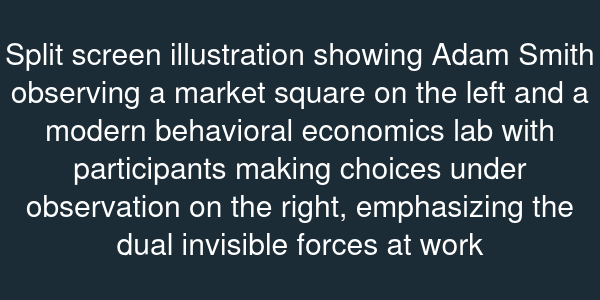Two Invisible Forces
Essential Questions
- How did Adam Smith frame the invisible hand, and why was it so persuasive?
- What kinds of human behavior fall outside Smith's assumptions?
- Why does a modern economics handbook need to account for psychology as well as prices?
Overview
You step onto a bustling trading floor where prices flicker like fireflies. Traders claim that if you leave the market alone, it will guide resources to their best use. That promise traces back to Adam Smith's "invisible hand," the idea that self-interest aligns with social good. But as you watch, you notice hesitation, hunches, and herd behavior. The invisible hand seems to be sharing the stage with another invisible actor—the quirks of human psychology.
When you plan your own investments, you notice the same tension. A spreadsheet says to stay the course, yet fear spikes when headlines scream recession. Smith never ignored emotions, but classical models that followed him often did. This course invites you into a richer conversation: what happens when we place psychological realism alongside elegant mathematics?
From Smith's Marketplace to Behavioral Labs
The invisible hand emerged in an eighteenth-century world of merchants and moral philosophers. Smith believed competition disciplines greed. If a baker charges too much, customers defect. In calculus terms, we can express the first-order condition of a competitive firm as , where is price and is marginal cost. When every firm equates marginal cost to the same price, resources flow efficiently.
Modern economies, however, rarely meet Smith's assumptions. Behavioral economists run experiments where two choices with the same expected payoff produce wildly different decisions depending on framing. The Allais paradox, for instance, shows people violating the independence axiom of expected utility. Participants prefer a guaranteed million over a chance of million plus a chance of million, but flip preferences when probabilities shrink. The invisible hand presumes consistent preferences; the paradox reveals otherwise.

Why Build an Invisible Handbook?
You will use this course as a dual lens. On one side, you will revisit the foundational mathematics of rational choice: utility functions, constrained optimization, and the logic of equilibrium. On the other side, you will map systematic deviations—loss aversion, hyperbolic discounting, and social preferences—that bend outcomes away from classical predictions. The math remains: we still integrate over probability distributions and compute optimal strategies. But we allow parameters to capture psychology, such as a loss-aversion coefficient .
Consider a simple consumption-saving problem. Classical theory solves subject to . Behavioral data show that often collapses when rewards are immediate. Hyperbolic discounting rewrites the objective as with , producing preference reversals. Markets built on hyperbolic agents can experience under-saving or debt spirals even without external shocks.
Invisible Forces in Policy and Markets
The handbook you are building will guide you through labor markets, financial bubbles, and public policy where invisible biases matter. The 2008 mortgage crisis, for example, cannot be understood solely through supply-demand curves; overconfidence and herding amplified leverage. Behavioral insights now shape retirement plans, carbon policy, and consumer protection. As you move through each unit, you will connect rigorous models to real interventions, from automatic enrollment in 401(k)s to nudges in organ donation.
Classical economics taught us to trust decentralized decisions. Behavioral economics asks when we should question them. By the end of this unit you will be fluent in both dialects and prepared to assess when the invisible hand needs an invisible handbook.